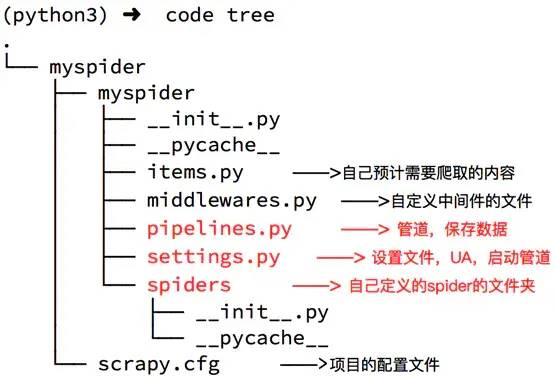python 爬取京東指定商品評(píng)論并進(jìn)行情感分析
https://github.com/DA1YAYUAN/JD-comments-sentiment-analysis
爬取京東商城中指定商品下的用戶評(píng)論,對(duì)數(shù)據(jù)預(yù)處理后基于SnowNLP的sentiment模塊對(duì)文本進(jìn)行情感分析。
運(yùn)行環(huán)境 Mac OS X Python3.7 requirements.txt Pycharm 運(yùn)行方法數(shù)據(jù)爬取(jd.comment.py) 啟動(dòng)jd_comment.py,建議修改jd_comment.py中變量user-agent為自己瀏覽器用戶代理 輸入京東商品完整URL 得到京東評(píng)論詞云,存放于jd_ciyun.jpg(詞云輪廓形狀存放于jdicon.jpg) 得到京東評(píng)論數(shù)據(jù),存放于jd_comment.csvimport osimport timeimport jsonimport randomimport csvimport reimport jiebaimport requestsimport numpy as npfrom PIL import Imageimport matplotlib.pyplot as pltfrom wordcloud import WordCloud# 詞云形狀圖片WC_MASK_IMG = ’jdicon.jpg’# 評(píng)論數(shù)據(jù)保存文件COMMENT_FILE_PATH = ’jd_comment.txt’# 詞云字體WC_FONT_PATH = ’/Library/Fonts/Songti.ttc’def spider_comment(page=0, key=0): ''' 爬取京東指定頁(yè)的評(píng)價(jià)數(shù)據(jù) :param page: 爬取第幾,默認(rèn)值為0 ''' url = ’https://club.jd.com/comment/productPageComments.action?callback=fetchJSON_comment98vv4646&productId=’ + key + ’’ ’&score=0&sortType=5&page=%s&pageSize=10&isShadowSku=0&fold=1’ % page kv = {’user-agent’: ’Mozilla/5.0’, ’Referer’: ’https://item.jd.com/’+ key + ’.html’}#原本key不輸入值,默認(rèn)為《三體》 try:r = requests.get(url, headers=kv)r.raise_for_status() except:print(’爬取失敗’) # 截取json數(shù)據(jù)字符串 r_json_str = r.text[26:-2] # 字符串轉(zhuǎn)json對(duì)象 r_json_obj = json.loads(r_json_str) # 獲取評(píng)價(jià)列表數(shù)據(jù) r_json_comments = r_json_obj[’comments’] # 遍歷評(píng)論對(duì)象列表 for r_json_comment in r_json_comments:# 以追加模式換行寫入每條評(píng)價(jià)with open(COMMENT_FILE_PATH, ’a+’) as file: file.write(r_json_comment[’content’] + ’n’)# 打印評(píng)論對(duì)象中的評(píng)論內(nèi)容print(r_json_comment[’content’])def batch_spider_comment(): '''批量爬取某東評(píng)價(jià)''' # 寫入數(shù)據(jù)前先清空之前的數(shù)據(jù) if os.path.exists(COMMENT_FILE_PATH):os.remove(COMMENT_FILE_PATH) key = input('Please enter the address:') key = re.sub('D','',key) #通過(guò)range來(lái)設(shè)定爬取的頁(yè)面數(shù) for i in range(10):spider_comment(i,key)# 模擬用戶瀏覽,設(shè)置一個(gè)爬蟲間隔,防止ip被封time.sleep(random.random() * 5)def cut_word(): ''' 對(duì)數(shù)據(jù)分詞 :return: 分詞后的數(shù)據(jù) ''' with open(COMMENT_FILE_PATH) as file:comment_txt = file.read()wordlist = jieba.cut(comment_txt, cut_all=False)#精確模式wl = ' '.join(wordlist)print(wl)return wldef create_word_cloud(): '''44144127306 生成詞云 :return: ''' # 設(shè)置詞云形狀圖片 wc_mask = np.array(Image.open(WC_MASK_IMG)) # 設(shè)置詞云的一些配置,如:字體,背景色,詞云形狀,大小 wc = WordCloud(background_color='white', max_words=2000, mask=wc_mask, scale=4, max_font_size=50, random_state=42, font_path=WC_FONT_PATH) # 生成詞云 wc.generate(cut_word()) # 在只設(shè)置mask的情況下,你將會(huì)得到一個(gè)擁有圖片形狀的詞云 plt.imshow(wc, interpolation='bilinear') plt.axis('off') plt.figure() plt.show() wc.to_file('jd_ciyun.jpg')def txt_change_to_csv(): with open(’jd_comment.csv’, ’w+’, encoding='utf8', newline=’’)as c:writer_csv = csv.writer(c, dialect='excel')with open('jd_comment.txt', ’r’, encoding=’utf8’)as f: # print(f.readlines()) for line in f.readlines():# 去掉str左右端的空格并以空格分割成listline_list = line.strip(’n’).split(’,’)print(line_list)writer_csv.writerow(line_list)if __name__ == ’__main__’: # 爬取數(shù)據(jù) batch_spider_comment() #轉(zhuǎn)換數(shù)據(jù) txt_change_to_csv() # 生成詞云 create_word_cloud()模型訓(xùn)練(train.py) 準(zhǔn)備正負(fù)語(yǔ)料集online_shopping_10_cats.csv,分別存入negative.txt和positive.txt 啟動(dòng)train.py,新建文件sentiment.marshal,存入訓(xùn)練后的模型 找到外部庫(kù)中snownlp中sentiment模塊,將訓(xùn)練得到的sentiment.marshal.3文件覆蓋sentiment模塊中自帶的sentiment.marshal.3
# -*-coding:utf-8-*-def train(): from snownlp import sentiment print('開始訓(xùn)練數(shù)據(jù)集...') sentiment.train(’negative.txt’, ’positive.txt’)#自己準(zhǔn)備數(shù)據(jù)集 sentiment.save(’sentiment.marshal’)#保存訓(xùn)練模型 #python2保存的是sentiment.marshal;python3保存的是sentiment.marshal.3 '訓(xùn)練完成后,將訓(xùn)練完的模型,替換sentiment中的模型'def main(): train() # 訓(xùn)練正負(fù)向商品評(píng)論數(shù)據(jù)集 print('數(shù)據(jù)集訓(xùn)練完成!')if __name__ == ’__main__’: main()情感分析(sentiment.analysis.py) 啟動(dòng)sentiment.analysis.py 開始對(duì)jd_comment.csv中評(píng)論進(jìn)行數(shù)據(jù)處理,處理后文件存入processed_comment_data.csv sentiment模塊根據(jù)sentiment.marshal.3對(duì)評(píng)論進(jìn)行情感評(píng)分,評(píng)分結(jié)果存入result.csv 評(píng)分結(jié)果可視化,生成文件fig.png
from snownlp import sentimentimport pandas as pdimport snownlpimport matplotlib.pyplot as pltfrom matplotlib.font_manager import FontProperties#from word_cloud import word_cloud_creation, word_cloud_implementation, word_cloud_settingsdef read_csv(): ’’’讀取商品評(píng)論數(shù)據(jù)文件’’’ comment_data = pd.read_csv(’jd_comment.csv’, encoding=’utf-8’, sep=’n’, index_col=None) #返回評(píng)論作為參數(shù) return comment_datadef clean_data(data): ’’’數(shù)據(jù)清洗’’’ df = data.dropna() # 消除缺失數(shù)據(jù) NaN為缺失數(shù)據(jù) df = pd.DataFrame(df.iloc[:, 0].unique()) # 數(shù)據(jù)去重 return df # print(’數(shù)據(jù)清洗后:’, len(df))def clean_repeat_word(raw_str, reverse=False): ’’’去除評(píng)論中的重復(fù)使用的詞匯’’’ if reverse:raw_str = raw_str[::-1] res_str = ’’ for i in raw_str:if i not in res_str: res_str += i if reverse:res_str = res_str[::-1] return res_strdef processed_data(filename): ’’’清洗完畢的數(shù)據(jù),并保存’’’ df = clean_data(read_csv())#數(shù)據(jù)清洗 ser1 = df.iloc[:, 0].apply(clean_repeat_word)#去除重復(fù)詞匯 df2 = pd.DataFrame(ser1.apply(clean_repeat_word, reverse=True)) df2.to_csv(f’{filename}.csv’, encoding=’utf-8’, index_label=None, index=None)def train(): ’’’訓(xùn)練正向和負(fù)向情感數(shù)據(jù)集,并保存訓(xùn)練模型’’’ sentiment.train(’negative.txt’, ’positive.txt’) sentiment.save(’seg.marshal’)#python2保存的是sentiment.marshal;python3保存的是sentiment.marshal.3sentiment_list = []res_list = []def test(filename, to_filename): ’’’商品評(píng)論-情感分析-測(cè)試’’’ with open(f’{filename}.csv’, ’r’, encoding=’utf-8’) as fr:for line in fr.readlines(): s = snownlp.SnowNLP(line) #調(diào)用snownlp中情感評(píng)分s.sentiments if s.sentiments > 0.6:res = ’喜歡’res_list.append(1) elif s.sentiments < 0.4:res = ’不喜歡’res_list.append(-1) else:res = ’一般’res_list.append(0) sent_dict = {’情感分析結(jié)果’: s.sentiments,’評(píng)價(jià)傾向’: res,’商品評(píng)論’: line.replace(’n’, ’’) } sentiment_list.append(sent_dict) print(sent_dict)df = pd.DataFrame(sentiment_list)df.to_csv(f’{to_filename}.csv’, index=None, encoding=’utf-8’, index_label=None, mode=’w’)def data_virtualization(): ’’’分析結(jié)果可視化,以條形圖為測(cè)試樣例’’’ font = FontProperties(fname=’/System/Library/Fonts/Supplemental/Songti.ttc’, size=14) likes = len([i for i in res_list if i == 1]) common = len([i for i in res_list if i == 0]) unlikes = len([i for i in res_list if i == -1]) plt.bar([1], [likes], label=’喜歡’)#(坐標(biāo),評(píng)論長(zhǎng)度,名稱) plt.bar([2], [common], label=’一般’) plt.bar([3], [unlikes], label=’不喜歡’) x=[1,2,3] label=[’喜歡’,’一般’,’不喜歡’] plt.xticks(x, label) plt.legend()#插入圖例 plt.xlabel(’評(píng)價(jià)種類’) plt.ylabel(’評(píng)價(jià)數(shù)目’) plt.title(u’商品評(píng)論情感分析結(jié)果-條形圖’, FontProperties=font) plt.savefig(’fig.png’) plt.show()’’’def word_cloud_show(): #將商品評(píng)論轉(zhuǎn)為高頻詞匯的詞云 wl = word_cloud_creation(’jd_comment.csv’) wc = word_cloud_settings() word_cloud_implementation(wl, wc)’’’def main(): processed_data(’processed_comment_data’)#數(shù)據(jù)清洗 #train() # 訓(xùn)練正負(fù)向商品評(píng)論數(shù)據(jù)集 test(’jd_comment’, ’result’) print(’數(shù)據(jù)可視化中...’) data_virtualization() # 數(shù)據(jù)可視化 print(’python程序運(yùn)行結(jié)束。’)if __name__ == ’__main__’: main()詞云輪廓圖



以上就是python 爬取京東指定商品評(píng)論并進(jìn)行情感分析的詳細(xì)內(nèi)容,更多關(guān)于python 爬取京東評(píng)論并進(jìn)行情感分析的資料請(qǐng)關(guān)注好吧啦網(wǎng)其它相關(guān)文章!
相關(guān)文章:
1. 一文讀懂python Scrapy爬蟲框架2. Python如何批量生成和調(diào)用變量3. 通過(guò)CSS數(shù)學(xué)函數(shù)實(shí)現(xiàn)動(dòng)畫特效4. ASP.Net Core對(duì)USB攝像頭進(jìn)行截圖5. Python獲取B站粉絲數(shù)的示例代碼6. .net如何優(yōu)雅的使用EFCore實(shí)例詳解7. windows服務(wù)器使用IIS時(shí)thinkphp搜索中文無(wú)效問(wèn)題8. ajax動(dòng)態(tài)加載json數(shù)據(jù)并詳細(xì)解析9. python實(shí)現(xiàn)自冪數(shù)的示例代碼10. ASP.NET MVC實(shí)現(xiàn)橫向展示購(gòu)物車

 網(wǎng)公網(wǎng)安備
網(wǎng)公網(wǎng)安備